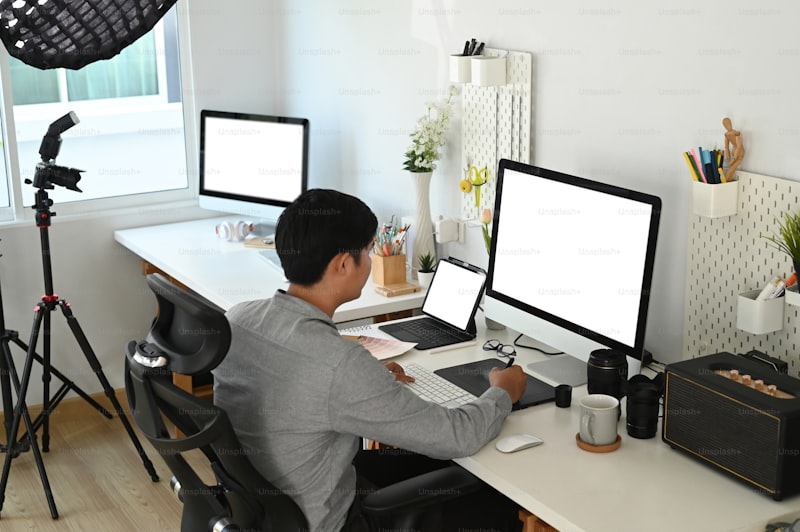One of the top trends in office design for maximum productivity is the shift towards open and flexible spaces. Gone are the days of cubicles and closed-off offices. Modern offices are embracing open layouts that foster collaboration and communication among team members. These spaces often include versatile furniture arrangements that can be easily reconfigured to suit different tasks and group sizes, promoting a dynamic work environment.
Another significant trend is the integration of biophilic design principles. Incorporating elements of nature such as plants, natural light, and sustainable materials into office spaces has been shown to reduce stress, enhance creativity, and boost overall well-being. Green walls, indoor gardens, and large windows that bring in ample natural light are becoming increasingly common features in today’s workplaces.
Technology also plays a pivotal role in shaping office design trends. With the rise of remote work and digital collaboration tools, offices are being equipped with state-of-the-art technology that supports seamless connectivity and communication. This includes smart building systems, ergonomic furniture with built-in charging stations, and flexible AV setups for virtual meetings.
Furthermore, wellness-focused design elements are gaining traction as employers prioritize employee health and happiness. Ergonomic furniture, dedicated spaces for relaxation or meditation, and even on-site fitness centers are becoming standard in many modern offices. These amenities not only enhance physical health but also contribute to a more positive and productive work environment.
The evolution of office design trends is driven by a desire to create environments that support productivity, foster innovation, and prioritize employee well-being. By embracing open layouts, biophilic elements, advanced technology, and wellness-focused design principles, companies can create workplaces that inspire creativity and promote peak performance among their teams.
Biophilic Bliss: Integrating Nature into Office Spaces for Productivity
Imagine stepping into an office where lush greenery welcomes you at every turn. Plants not only beautify the space but also purify the air, creating a fresher, healthier atmosphere. Studies show that exposure to greenery can reduce stress levels and boost cognitive function, fostering a more productive work environment.
Natural light streaming through large windows not only cuts down on energy costs but also lifts spirits and enhances mood. Employees feel more connected to the outside world, rejuvenated by the changing patterns of sunlight throughout the day. This connection to natural rhythms helps regulate circadian rhythms, leading to better sleep patterns and higher productivity levels.
Integrating natural textures like wood and stone into office decor adds a tactile dimension that grounds employees in their surroundings. These elements evoke a sense of calm and authenticity, creating spaces that feel more like home than a traditional office. Employees are more likely to feel relaxed and motivated in environments that resonate with nature’s simplicity and elegance.
Even the simplest of changes, like incorporating water features or natural art installations, can have a profound impact on workplace morale and creativity. The soothing sound of flowing water or the visual allure of natural sculptures can inspire innovative thinking and foster a sense of community among colleagues.

Ultimately, biophilic design isn’t just about aesthetics—it’s about creating environments that support human well-being and productivity. By bringing nature indoors, employers can enhance the overall quality of the work experience, fostering happier, healthier, and more engaged employees.
Incorporating biophilic elements into office spaces isn’t just a trend; it’s a transformative approach to workplace design that nurtures both people and productivity. By embracing nature, companies can cultivate environments where creativity flourishes, stress diminishes, and success thrives.
Flexible Workspaces: Adaptable Designs That Boost Efficiency
These spaces are more than just desks and chairs arranged in an open layout. They’re dynamic environments that cater to the diverse tasks and preferences of modern workers. Picture this: in one corner, a cozy lounge area with soft lighting and comfortable seating, perfect for brainstorming sessions or casual meetings. Nearby, modular desks and movable partitions allow for quick reconfiguration, accommodating both individual workstations and collaborative areas as needed.
One of the key benefits of flexible workspaces is their ability to enhance productivity. By providing options for different work styles, they empower employees to choose where and how they work best. This freedom promotes creativity and minimizes the monotony often associated with traditional office setups. Instead of feeling confined to a single desk from 9 to 5, workers can move around throughout the day, finding inspiration in new surroundings.
Efficiency is further amplified through smart utilization of space. Flexible designs optimize square footage by eliminating unused areas and maximizing functionality. For instance, shared spaces like meeting rooms and breakout areas can be booked on demand, ensuring they’re utilized efficiently without sitting empty for hours. This not only saves on real estate costs but also fosters a more collaborative and agile work environment.
Moreover, the adaptability of these spaces aligns well with the changing needs of businesses today. Whether scaling up operations, accommodating remote teams, or integrating new technologies, flexible workspaces offer a scalable solution. They can easily evolve with the organization, adapting to future challenges and opportunities without major renovations or disruptions.
Smart Offices: How Technology Is Revolutionizing Workplace Productivity
One of the most impactful innovations in smart offices is IoT (Internet of Things). IoT connects devices and systems, enabling them to communicate and work together seamlessly. For example, sensors can monitor occupancy levels in meeting rooms, automatically adjusting the environment for comfort and efficiency. This not only enhances productivity but also promotes energy conservation, aligning with sustainability goals.

Moreover, artificial intelligence (AI) plays a pivotal role in shaping smart offices. AI-powered assistants streamline tasks like scheduling meetings, managing emails, and even ordering office supplies. These assistants learn from user interactions, becoming more intuitive over time and freeing up employees to focus on high-value activities.

Another game-changer is smart lighting systems. These systems adjust brightness and color temperature based on natural light levels and user preferences. Studies show that optimized lighting can boost productivity and well-being, reducing eye strain and fatigue.
Security is also enhanced in smart offices. Access control systems using biometrics or digital badges ensure that only authorized personnel can enter sensitive areas. AI-driven surveillance cameras analyze video feeds in real-time, alerting security teams to potential threats proactively.
Mindful Design: Creating Calm and Focus Through Office Layouts
Mindful design isn’t just about aesthetics; it’s a thoughtful approach that considers how the physical environment impacts our mental and emotional well-being. Picture large windows welcoming natural light, gently illuminating spacious, uncluttered work areas. This isn’t just about beauty—it’s about functionality too. Natural light not only reduces the need for artificial lighting but also enhances mood and boosts vitamin D levels, crucial for overall health.
Ever noticed how certain spaces make you feel instantly relaxed? That’s the magic of mindful design. It’s about incorporating elements that resonate with our senses, like soft textures, soothing colors, and even the strategic placement of greenery. Plants aren’t just decorative; they purify the air and create a connection to nature, fostering a serene ambiance that helps us stay grounded amidst deadlines and meetings.
Consider the layout itself as a canvas where productivity meets peace. Open spaces encourage collaboration and a sense of community, while designated quiet zones provide refuge for focused work. It’s all about balance—creating areas that cater to different needs without sacrificing harmony. Just like a well-composed piece of music, each element in a mindfully designed office contributes to the overall symphony of productivity and well-being.
And what about those little details that often go unnoticed? Think ergonomic furniture that supports health and comfort, acoustic panels that minimize noise, and smart storage solutions that declutter the workspace. These elements aren’t just additions; they’re essentials that ensure the office is a place where creativity thrives and stress dissipates.

In essence, mindful design in office layouts isn’t a trend; it’s a revolution in how we perceive and interact with our work environment. By blending aesthetics with functionality, it transforms offices into sanctuaries of focus, creativity, and well-being. After all, when our surroundings nurture us, our potential to excel knows no bounds.
Wellness at Work: The Rise of Ergonomic Furniture and Design
So, what exactly is ergonomic furniture? It’s not just about having stylish desks and chairs; it’s about optimizing the workspace to fit the needs of the human body. Think of it as furniture that adapts to you, rather than the other way around. From adjustable standing desks that allow you to switch between sitting and standing positions effortlessly, to chairs with lumbar support and adjustable armrests that promote proper posture, ergonomic furniture is designed with the user’s comfort and health in mind.
Why has there been such a surge in popularity? Well, it’s no secret that sitting for prolonged periods can lead to a host of health issues, including back pain, neck strain, and even reduced productivity. Ergonomic furniture helps mitigate these issues by encouraging movement and providing support where it’s needed most. Imagine being able to work comfortably for hours without feeling the usual aches and pains – that’s the promise of ergonomic design.
Moreover, businesses are beginning to realize that investing in their employees’ well-being pays off in the long run. Happy, healthy employees are more engaged, more productive, and less likely to take sick days. It’s a win-win situation for everyone involved.
As the demand for ergonomic solutions grows, so too does the variety of options available. Whether you work in a traditional office setting, a co-working space, or even from home, there’s an ergonomic solution that can work for you. From sleek, modern designs to more traditional styles, ergonomic furniture blends seamlessly into any workspace while providing the comfort and support you need to thrive.
Frequently Asked Questions
What role do flexible workspaces play in boosting employee productivity?
Flexible workspaces enhance employee productivity by providing adaptable environments that cater to diverse work styles and needs. They promote autonomy, collaboration, and well-being, fostering a more motivated and efficient workforce.
How can ergonomic office furniture improve workplace efficiency?
Discover how ergonomic office furniture enhances workplace efficiency by promoting better posture, reducing discomfort, and increasing productivity through improved comfort and support.
How can biophilic design elements benefit workplace morale and performance?
Learn how integrating biophilic design elements into the workplace can enhance morale and performance by fostering a connection with nature. Discover the positive impact on employee well-being, creativity, and productivity.
Why is natural lighting important in modern office environments?
Discover why natural lighting is crucial in modern offices. Learn how it enhances productivity, mood, and energy levels among employees, while reducing energy costs and creating a healthier workspace.
What are the current trends in office design that enhance productivity?
Discover the latest trends in office design that optimize productivity. Explore innovative layouts, ergonomic furniture, biophilic elements, and smart technology integrations.



[…] Top Trends in Office Design for Maximum Productivity […]